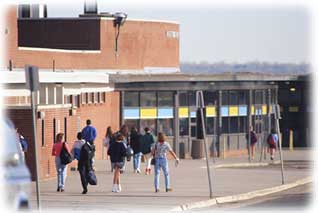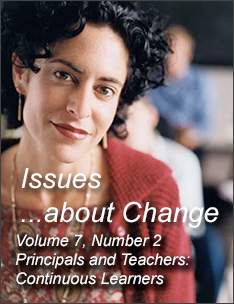Principals and Teachers: Continuous Learners
Introduction
We have been studying Professional Learning Communities (Hord, 1997), the settings where teachers and principals collaborate to continuously increase their effectiveness through their own ongoing learning. We have significantly increased our understanding of what these schools look like and how they operate.
 We have come to know these schools by what the staff is doing. At one school, we watched a committee of teachers planning for staff development for the whole staff. They were not simply putting together a wish list; they had researched student needs and interests and needs of the teaching staff, resources that matched these interests, and were applying numbers from the budget they had been given by their principal. In another school, the new math program in the school came from several teachers who attended a workshop and brought the ideas back to the faculty as a whole.
We have come to know these schools by what the staff is doing. At one school, we watched a committee of teachers planning for staff development for the whole staff. They were not simply putting together a wish list; they had researched student needs and interests and needs of the teaching staff, resources that matched these interests, and were applying numbers from the budget they had been given by their principal. In another school, the new math program in the school came from several teachers who attended a workshop and brought the ideas back to the faculty as a whole.
In these Professional Learning Communities (PLC) schools, the teachers and administrators are actively involved in gathering information, making decisions, and implementing those decisions. They are active in their own learning and are open to new ideas. When they have examined the options and determined the best course of action, they take measured risks in the implementation of their decisions. They display their commitment to their schools and students by their enthusiasm for their profession and their concern for students. The occasional evening meeting without additional pay is not unusual for these teachers.
We are finding clear evidence that one of the keys to the existence of these PLCs is the administrator. So we have been asking: How do these principals operate in their role as principal to develop settings where all professional staff members take responsibility for the highest quality learning possible at the school? While we cannot yet generalize broadly about who is likely to use a leadership role in this way, we can say something about the approaches in the five schools we have studied. In one school, the principal took advantage of a crisis to mobilize the staff and engage them in collegial problem solving so that they explored and learned about solutions for the problems. In a second school, the principal seized an opportunity to develop a learning community among her staff in order to study the possibilities and advantages of implementing a new curriculum that was being offered to the school. In the remaining three schools, the principals were continuous learners and they transferred their continuous learning practices to their staffs to create a community of professional learners. How these three principals expressed their own learning and the nurturing of learning in their staffs is the focus of this paper.
Next Page: Three Principals Who Are Continuous Learners

